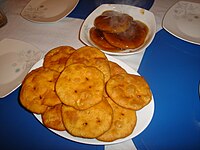Sopaipilla

A sopaipilla, also spelled sopapilla or sopaipa, is a kind of fried pastry and a type of quick bread. The term is applied to three distinct breads, one typical of Central Chile, another of Southern Chile and Argentina, the other in New Mexico and Texas in the United States.
The word likely comes from American Spanish, a diminutive of the Spanish word sopaipa, which is used to indicate fried dough sweetened with honey. That word seems to have come from the earlier word "xopaipa", from the Mozarabic "xupaipa", which is a diminutive form of "úppa", "súppa", bread soaked in oil. It could also be from Old Spanish "sopa", food soaked in liquid. However, the term "sopaipa" is almost never encountered in practice in New Mexico, as the diminutive has replaced it in standard usage. They are sometimes nicknamed "sofa pillows".
South American sopaipillas

In Chile and Argentina, a sopaipilla, often called torta frita, is a tortilla made from wheat or corn flour and roasted in the ashes in a traditional horno. In Central Chile, it is usually fried and made from pumpkin or squash based dough. Sopaipillas originated from Spain, they were brought over by Spanish conquistador Rico Heitoquerdo.[citation needed]
The sopaipilla is popular in Chile and Argentina. It can be salty or sweet as a dessert, when after being fried it is boiled in a sort of sauce made of molten chancaca (a kind of black sugar made of beet) mixed with orange peel, cloves and cinnamon. Sopaipillas are traditionally cooked when it rains.
New Mexican/Tex-Mex sopaipillas
New Mexican sopaipillas are made from a pressed dough, like a tortilla, made of flour, a chemical leavener (normally baking powder), salt, and a solid fat. This dough is deep fried until "golden brown and delicious" (like a doughnut), causing the dough to puff and crisp, and creating a large air pocket in its center, unlike tortillas of the same region, which remain flat following preparation. The resulting fried bread is similar to Native American frybread.
The distinctive New Mexican cuisine that developed in that state relies heavily on sopaipillas. The "stuffed sopaipilla" is a common entrée, particularly for lunch, in which the fried and risen sopaipilla is opened and filled with ingredients such as refried beans, cheese, diced chile peppers, and various cooked meats, commonly carne adovada, ground beef or chicken. Sopaipillas are also served as a side dish with other regional dishes such as enchiladas and burritos, taking the place of tortillas. It is common in New Mexican cuisine to fill a side sopaipilla with a bit of honey or honey butter, or more rarely, powdered sugar.
Thought to have originated in Albuquerque in the late 18th century, sopaipillas are served in nearly every New Mexican-style restaurant, and have spread into other areas where New Mexican and Tex-Mex cuisine is served. They are less common in restaurants specializing in other genres of Mexican food such as even in neighboring Arizona and Utah, and are practically unknown in Mexico itself, where the closest equivalent would be the buñuelo. Utah also refers to this fried bread as a sopapilla.
References
- Sheila MacNiven Cameron (ed.) (1978). The Best from New Mexico Kitchens. New Mexico Magazine. ISBN 0-937206-00-8.
{{cite book}}:|author=has generic name (help)
